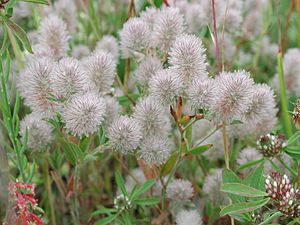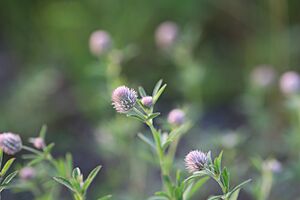Trifolium arvense facts for kids
Quick facts for kids Trifolium arvense |
|
|---|---|
 |
|
| Scientific classification | |
| Genus: |
Trifolium
|
| Species: |
arvense
|
Trifolium arvense is a type of flowering plant from the bean family, Fabaceae. It has several common names, including hare's-foot clover, rabbitfoot clover, and stone clover. It gets these names because its fluffy, pinkish-white flower heads look like a rabbit's or hare's foot.
This clover originally comes from most of Europe and western Asia. It grows well in dry, sandy soil and can be found along roadsides, in fields, and on sand dunes. The plant's scientific name, arvense, is Latin for "of the fields."
Contents
What Does Hare's-Foot Clover Look Like?
Hare's-foot clover is a small plant that usually grows between 10 and 40 centimeters tall. Like other clovers, it has leaves that are split into three parts, called leaflets. These leaflets are thin and about 1 to 2 centimeters long.
The most noticeable part of the plant is its flower cluster, called an inflorescence. These clusters are about 2 to 3 centimeters long and look like fuzzy, oblong balls. Each tiny flower is rosy-white and is covered in silky white hairs. These hairs make the flower head look soft and give the plant its unique name.
Where Does It Grow?
Hare's-foot clover is native to Europe, but it has spread to other parts of the world. It was introduced to North America and now grows in many places. You can find it in the eastern United States, southern Canada, and along the Pacific Coast. It has even been found in some parts of Hawaii.
This plant is not picky about where it lives. It can grow in soils that are either acidic or alkaline. It prefers dry spots and often pops up in places like the edges of fields, wastelands, and even in vineyards that are not watered often.
Life Cycle and Reproduction
Hare's-foot clover starts to flower in the early summer. It is a hermaphroditic plant, which means its flowers have both male and female parts. Because of this, it can pollinate itself, a process called autogamy. Bees also visit the flowers, which helps with cross-pollination between different plants.
After flowering, the plant produces a tiny pod with a single seed inside. The seeds have a very hard outer coat. This tough shell protects the seed and allows it to wait a long time before it starts to grow.
How People and Animals Use This Clover
This clover is useful in many ways, but it can also cause some problems.
Helping the Soil
Like most plants in the bean family, hare's-foot clover can perform nitrogen fixation. This is a special process where the plant takes nitrogen gas from the air and "fixes" it into the soil. This adds important nutrients to the soil, acting like a natural fertilizer for other plants. Because of this, it is often valued for improving poor-quality soils.
Food for Animals
Some animals, like sheep, goats, rabbits, and wild turkeys, enjoy eating hare's-foot clover. However, it can be dangerous for horses. The hairy flower heads can clump together in a horse's stomach and cause a serious blockage.
Scientific Research
Scientists have found this little clover very interesting. In New Zealand, researchers at AgResearch used genetic engineering to take a gene from hare's-foot clover and put it into white clover, a more common type fed to farm animals. This new clover could help reduce bloating in livestock and lower the amount of methane, a greenhouse gas, that they release. The release of this genetically modified clover was planned for around 2025.
A Helpful Plant, But Sometimes a Weed
Because it spreads easily, hare's-foot clover is sometimes considered an invasive species or a weed. In a small garden, it can be removed by hand. On a large farm, however, its tiny, tough seeds make it difficult to control. Farmers may need to use special methods to manage it and prevent it from taking over fields.
See also
 In Spanish: Pie de liebre para niños
In Spanish: Pie de liebre para niños



